This guide will help you to use the North Riding Register of Deeds when visiting the County Record Office. We suggest you also read the associated webpages which provide an introduction to the NRRD and answer some frequently asked questions about this collection, which summarise the key differences between the systems in operation before and after 1885, and the format of information you will find in the indexes and deeds. Two illustrated case studies are provided at the foot of this page, one before 1885 and the other after.
How do I start my search of the NRRD?
Unless you already know a volume, page and deed number, you should start with the indexes.
Because the deeds often contain reference(s) to earlier transaction(s), it is easier to work backwards in time than forwards, so we recommend starting with the post-1885 indexes.
Both systems are indexed by name and place, known as the indexes to parties (names) and indexes to lands (place). These indexes list the name of the parish or township, but do not include detailed addresses. You will need to look at the deeds themselves for details of the property they relate to. You may find, however, that in some of the later indexes, there is mention of a street name in some of the larger urban areas, e.g. Middlesbrough or Scarborough, particularly when several transactions in that place are listed under one party.
To use the indexes, you will need to know:
- the name of at least one of the people (parties) involved in the transaction (i.e. the buyer or seller) before 31 August 1970,
- the place (parish or township)
- an approximate idea of the date of the property sale/purchase.
If you don’t know who was a previous owner of a property before 31 August 1970, you may find a name that will help you in the 1939 Register, census records, the 1910 valuation field books, a tithe apportionment, trade directory or electoral registers. Be aware, however, that an occupier of a property is not necessarily the owner.

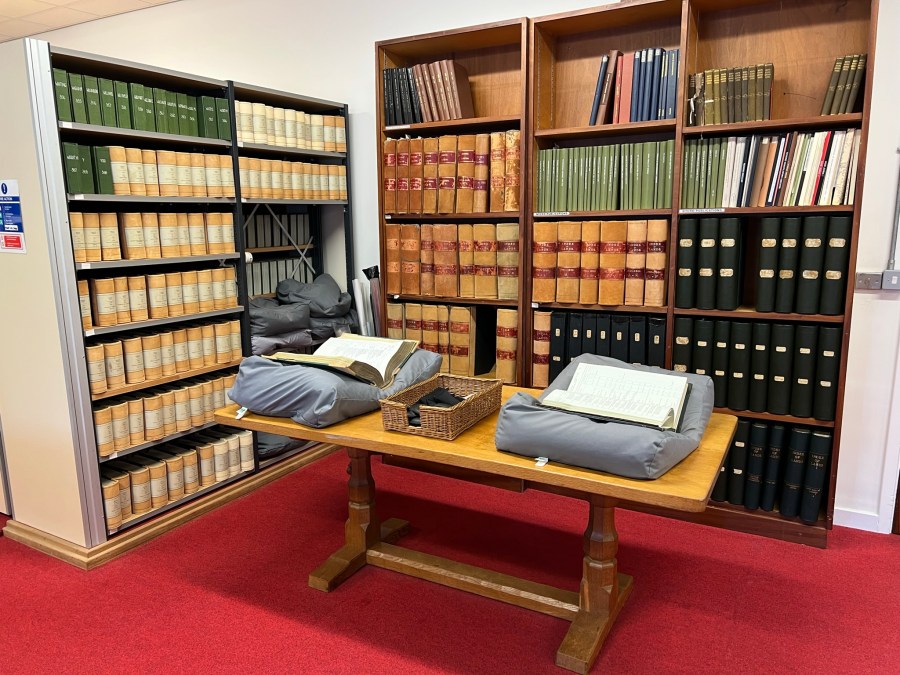

Locating the index books and deeds volumes:
Before 1885 – The NRRD records are held on microfilm. Use Appendix 1 in NYCRO Guide no.1 (pp.219-220) to find the relevant microfilm number, whether you are searching by name or place, for the index book(s) that cover the date range you are searching for. Once you have used the index and located the reference(s) to the deeds volume(s) you wish to view, you can use the same Appendix 1 to find the relevant microfilm number(s) for these volumes.
After 1885 – The original NRRD records may be consulted. Find the relevant index book(s) on the shelves in the search room, whether you are searching by name or place, that cover the date range you are searching for. Once you have found the references to the deed(s) you wish to view, make a note of the full reference(s) (volume number, page number and deed number), give the deeds volume number(s) to a member of staff in the search room and ask them to retrieve them for you. You do not need to fill out a document request slip.
Two examples of searches of the different systems of the NRRD:
Example 1 – Pre-1885: property in Millgate, Thirsk sold by John William Blackett in 1878
In this example, at the beginning of the search, we know that we are looking for a deed relating to property in Millgate, Thirsk sold by John William Blackett in 1878. You can, therefore, search for name Blackett in 1878, and/or the place Thirsk in 1878. Note that detailed addresses are not recorded in the indexes.
As the original index and deeds volumes are fragile, access to them is provided via self-service microfilm copies in our search room by prior appointment.
Step 1: Work out which microfilm you require to search either the index to parties (names) and/or the index to places
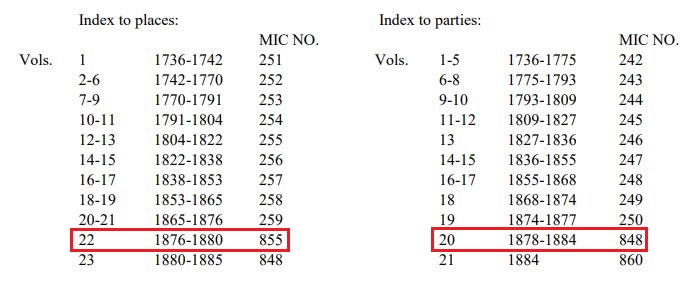
Using Appendix I of NYCRO Guide no. 1 (see extract above), you can identify that to search the NRRD index to parties (names) for Blackett in 1878, you will need volume 20, which covers the years 1878-1884 and is on microfilm no. 848.
Using the same Appendix I, you can work out that to search the NRRD index to places for Thirsk in 1878, you will need volume 22, which covers the years 1876-1880 and is on microfilm no. 855.
Step 2: Load the microfilm onto the self-service SL1000 viewer and search the indexes
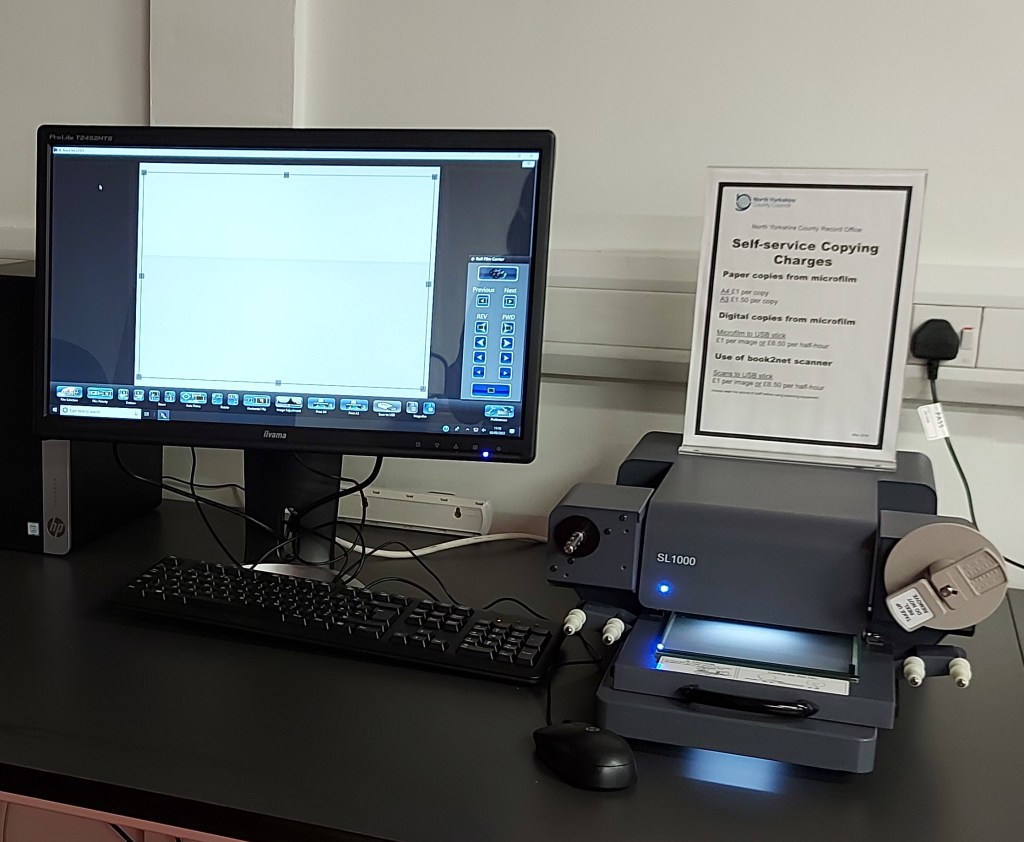
Taking one microfilm at a time from the search room filing cabinets in which they are housed in numerical order, use the self-service SL1000 readers in the search room to view the index.
You may also print out or copy images of individual microfilm frames. Black and white print-outs can be made at A4 and A3 size and images can be copied onto USB/memory stick for a small fee.
The indexes are handwritten and alphabetically arranged only by the first letter of the surname or place.
As the lists are not alphabetically arranged by the full name, you will need to look through all of the names or places to locate an entry for the name/place you are searching for. For example, in the image of the index to parties below for the letter ‘B’, you will see that the name Blackett appears amongst the entries listed in the following order: Boyes, Bellwood, Bargate, Blackett, Barbour, Baines, Butterfield.
Within each letter, the entries are listed by year. Note that these indexes show only the year of registration in the page margin at the start of that year’s entries, and not against each entry.
Therefore, to search volume 20 of the index to names for John William Blackett in 1878, start by locating the first of the pages for the letter ‘B’, then work your way through the entries looking in the page margin for the year 1878. Once you have found the start of the entries for that year, look through all the ‘B’ names for Blackett.
Note that many first names will also be abbreviated, for example John may be written as ‘Jno’, Charles as ‘Chas’, James as ‘Jas’, George as ‘Geo’, Robert ‘Robt’ and William as ‘Wm’.
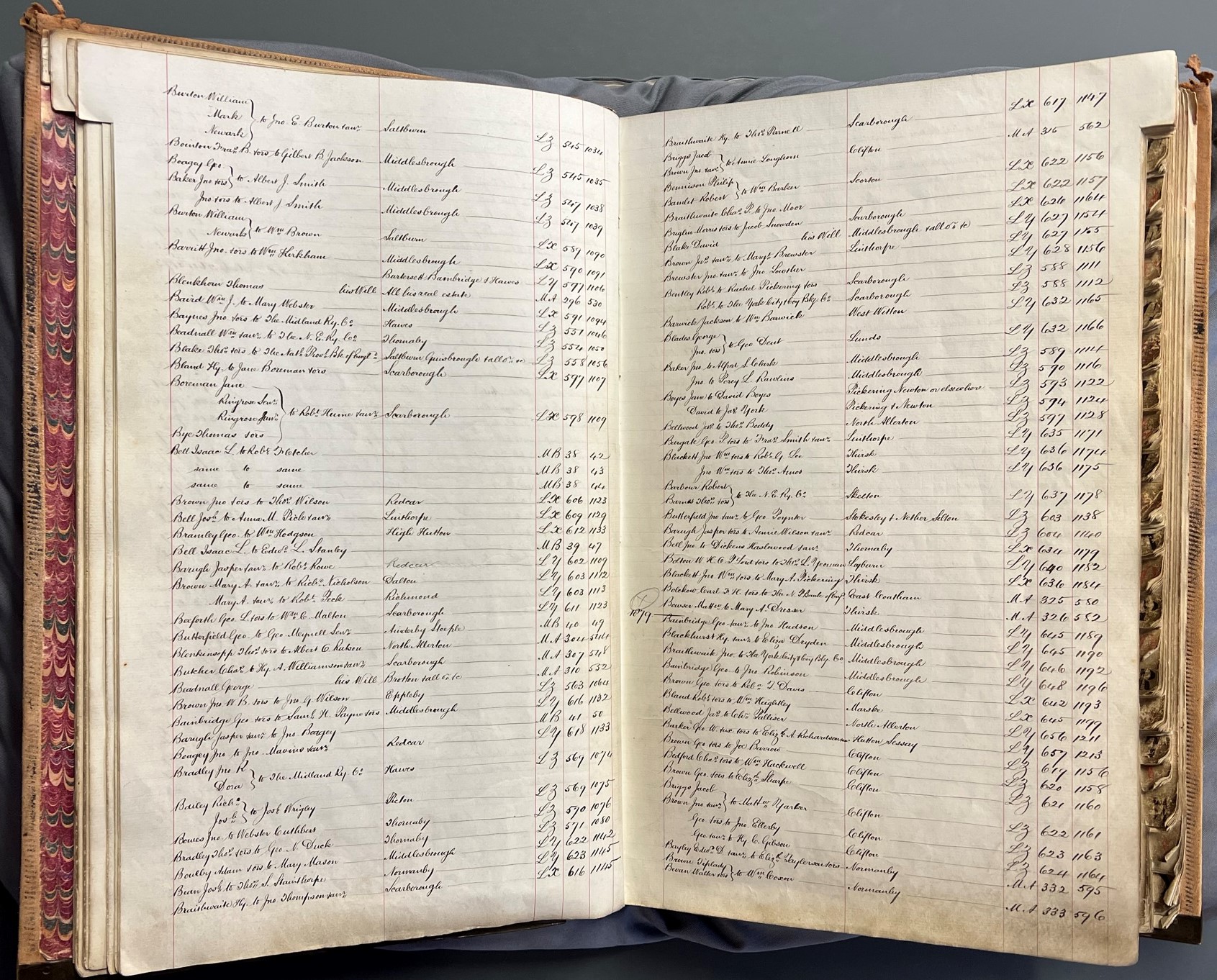

- Left: View of the original volume 20 of the NRRD index to names, open at the start of the pages for the letter ‘B’
- Right: Detail of the ‘B’ entries for the year 1878, with the name Blackett, John William, Thirsk highlighted & the deed reference on the right hand side of the page.
Step 3: Work out which deed references are relevant to your search
Having located the name Blackett in 1878 (see image highlighted above), the index will give you the details of the volume in which the related deed is held on the far right hand side of the page. In this example, there are two entries for John William Blackett pertaining to property in Thirsk. To be sure which refers to the Millgate property, you will need to consult the deeds themselves.
The deeds references are given in three parts: the volume reference/page number/deed number.
In this example, the two deed references for Blackett are LY/636/1174 and LY/636/1175. This shows that they are consecutive entries in the same deeds volume reference LY, on page no. 636 and deed numbers 1174 and 1175.
Similar information can be gained by searching the places index for Thirsk, which records the names of the other parties involved in the transaction. As with the names index, the year is written in the margin at the start of the entries for that year, and place-names are listed according to their first letter and not fully alphabetised (e.g. Tollerton, Topcliffe, Tholthorpe, Thirsk, Thormanby etc.), so you will need to search through all the entries for ‘T’ in the year 1878 (in the same way that all of the entries for the letter ‘B’ had to be searched above):
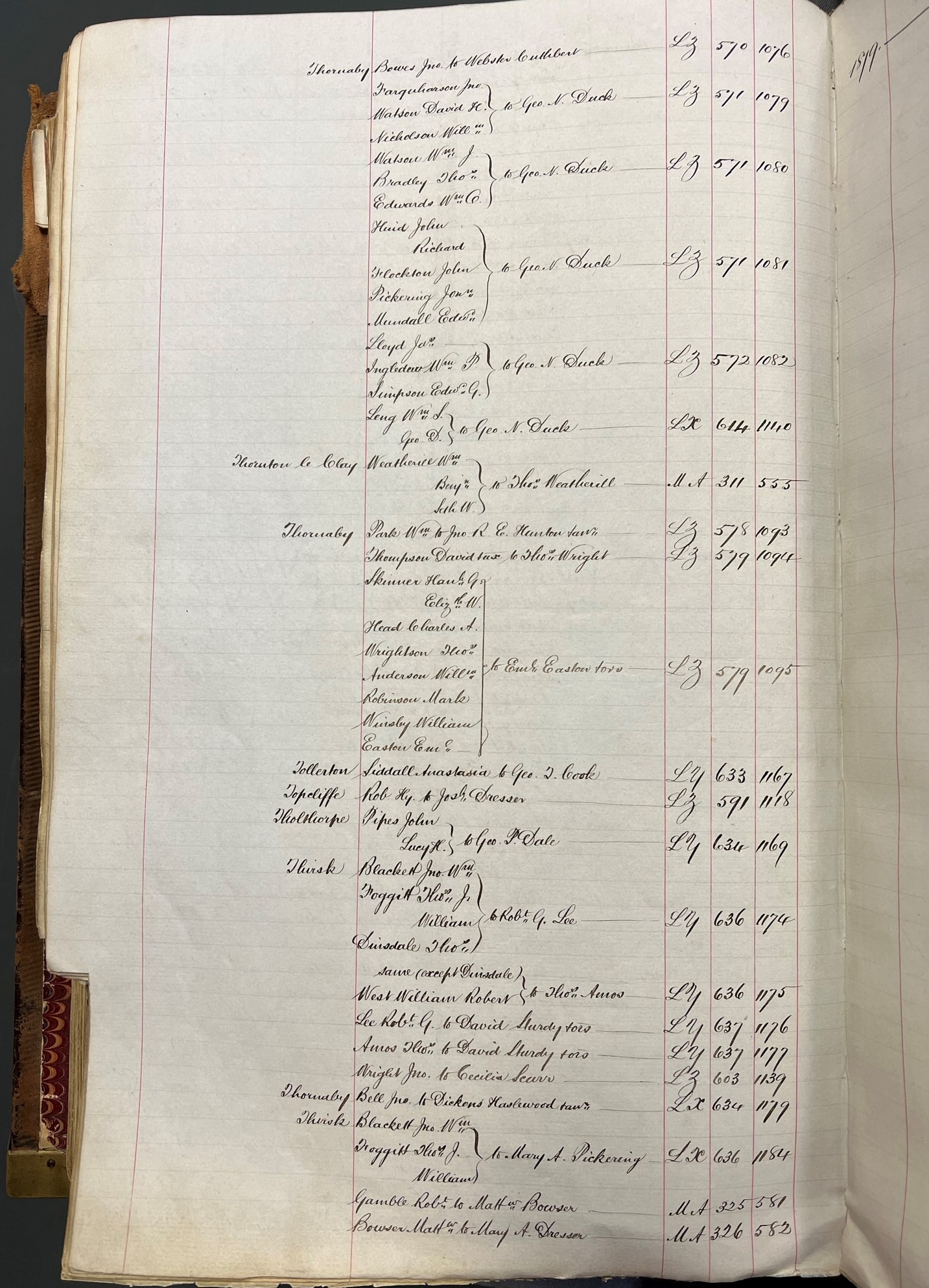
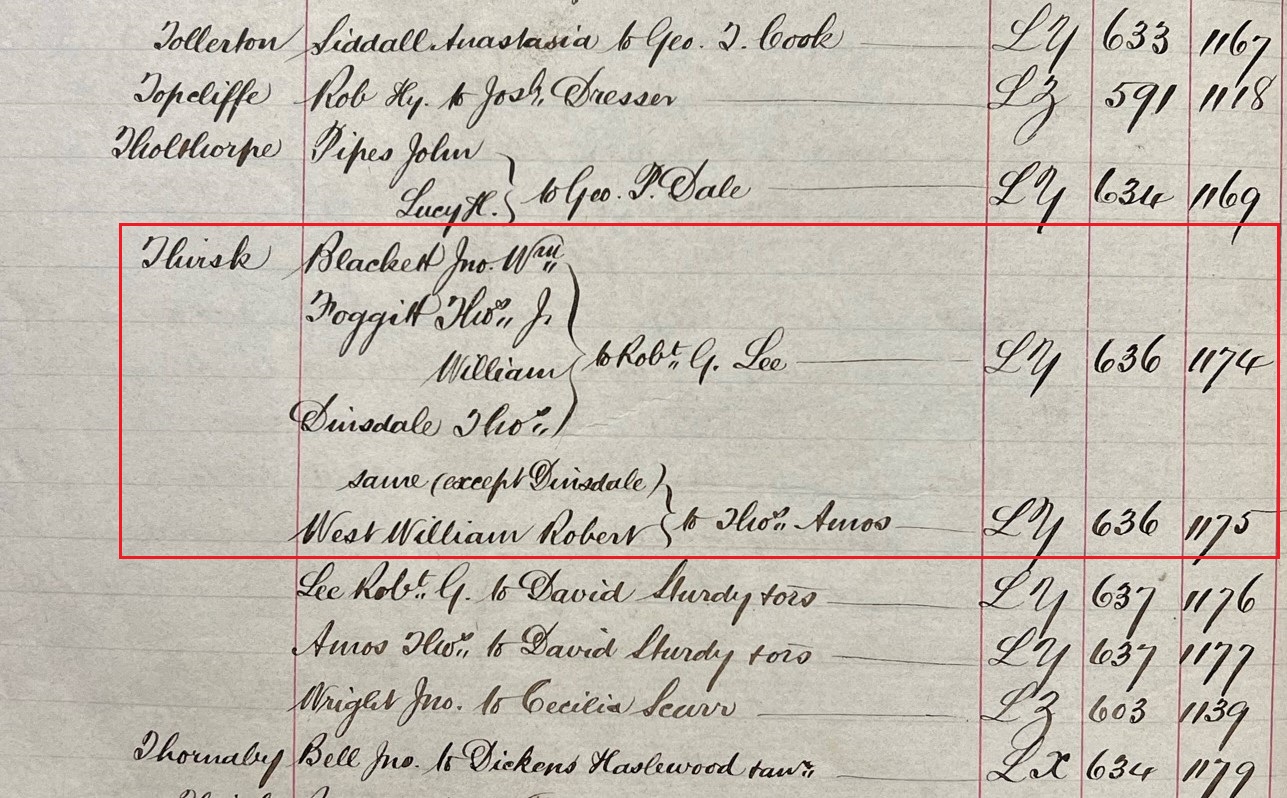
- Left: View of original page of volume 22 of the NRRD index to places, open at listings for the letter ‘T’ in 1878
- Right: Detail of the ‘T’ entries for the year 1878, with entries for Thirsk and the name Blackett, John William highlighted, & deeds reference to the far right hand side
Step 4: Work out which microfilm you require to view deeds LY/636/1174 and LY/636/1175
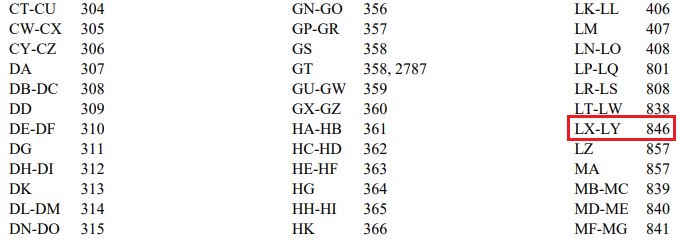
As highlighted in the image above, using the same Appendix I as in Step 1 above, you can work out that to view NRRD deeds volume LY, you will need to use microfilm no. 846, which also contains volume LX.
Step 5: Search NRRD volume ‘LY’ to view the two deed entries
Follow the same procedure as for Step 2 and load the microfilm on the reader. Be aware that some microfilms contain more than one NRRD volume, as in this instance. Be careful to ensure that you fast forward through the contents of the first volume LX to reach the next, LY.
Once you have located the start of volume LY, find page 636. The entries are handwritten and there may be more than one deed copied onto each page, depending upon their length. The deed number is usually the first part of each entry, written top left and highlighted within a rectangular box, as seen in the image below.

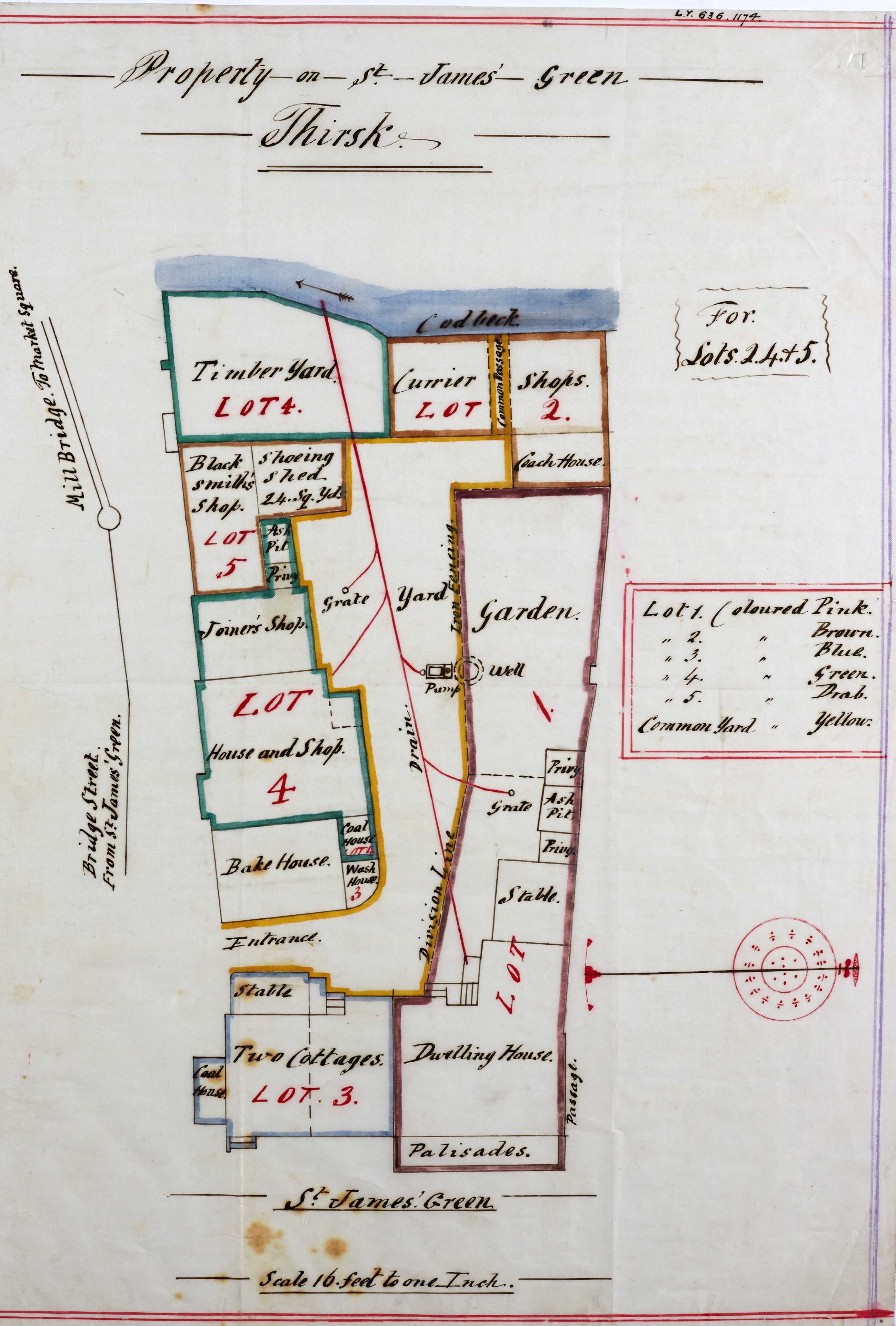
Memorial of an indenture, with plan, for dwelling houses, workshops with gardens & outbuildings, Millgate, Thirsk, 27 November 1878 (NRRD LY/636/1174)
From reading both the entries, you can identify that of the two deeds, deed number 1174 is the one that refers to the property on Millgate (see image above). There is also an accompanying coloured plan, which is rare in the pre-1885 deeds volumes.
The abbreviated details in the margin of page 636 record the main parties and the date and time of registration; fuller information is contained in the deed itself, as summarised below:
| NRRD reference | LY/636/1174 |
| The date of the original transaction | 27 November 1878 |
| The date and time of registration | 21 December 1878 at two in the afternoon |
| The type of instrument | Memorial (summary) of an indenture |
| The names of the people (parties) involved | John William Blackett, Wesleyan Minister of 37 Duffield Road, Derby Thomas Jackson Foggitt of Sowerby, Gentleman William Foggitt of Thirsk, Chemist Thomas Dinsdale of Thirsk, Innkeeper Robert Gibson Lee of Thirsk, Joiner & Cabinet Maker |
| A written description of the property | Several messuages, tenements or dwellinghouses, workshops & buildings with the garden late used as a timber yard. Together with the several outbuildings & conveniences situate in Millgate in Thirsk formerly the property of Edward Storey deceased & by him sold to John Blackett, delineated on the attached plan &c |
Example 2 – Post-1885: Blackburn Hall, Grinton purchased by Albany Kennett Charlesworth before the Second World War
In this example, at the beginning of the search, all we know is that we are looking for a deed relating to the purchase of Blackburn Hall, Grinton by Albany Kennett Charlesworth in the years before the Second World War – we do not know the exact year.
After 1885, the original index books known as indexes of names (parties) and lands (places) are accessible as bound volumes in the Record Office search room and may be searched self-service by prior appointment. The original, large green-leather-bound deeds volumes are held in a separate store and are retrieved on request by search room staff.
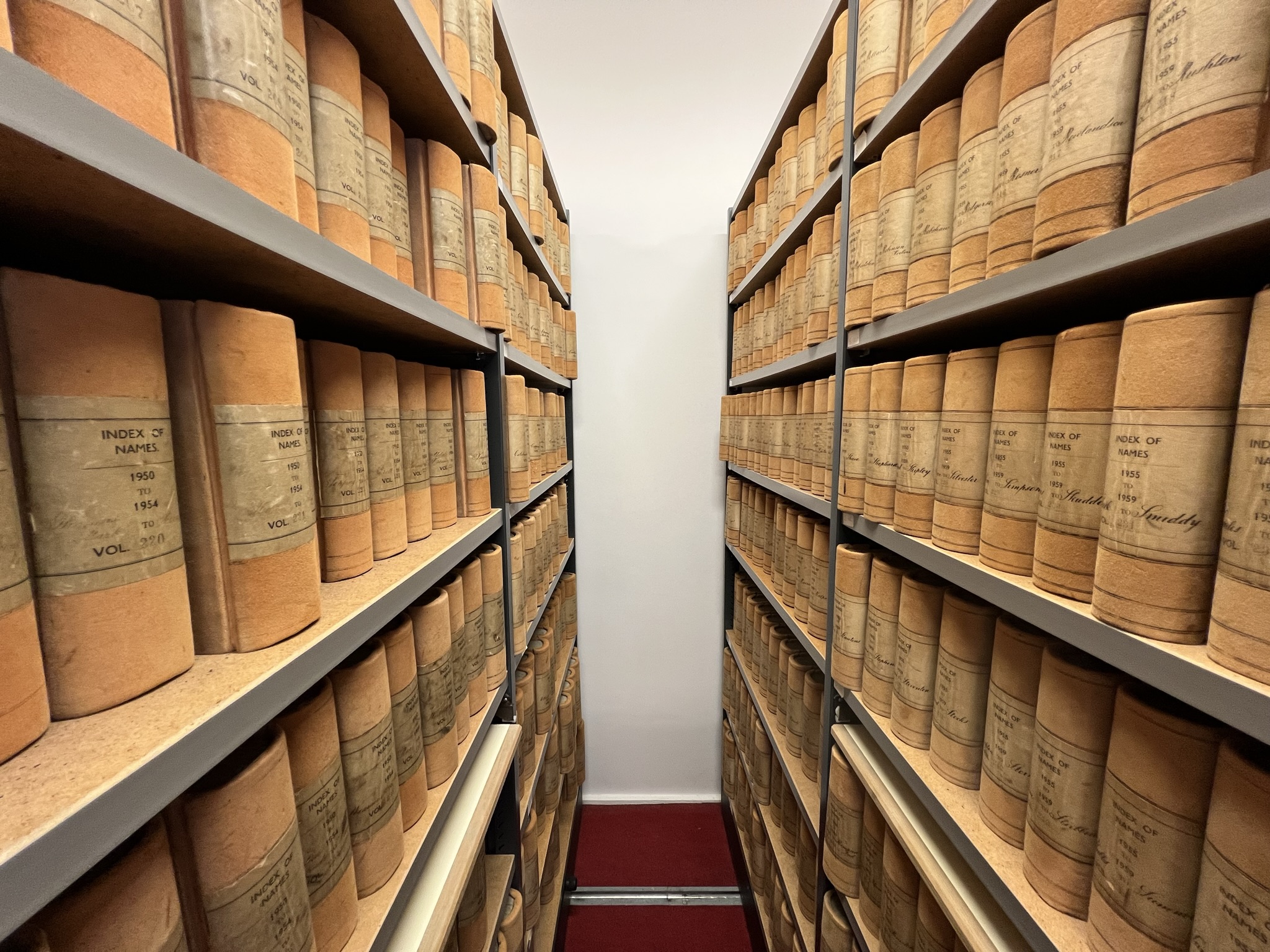

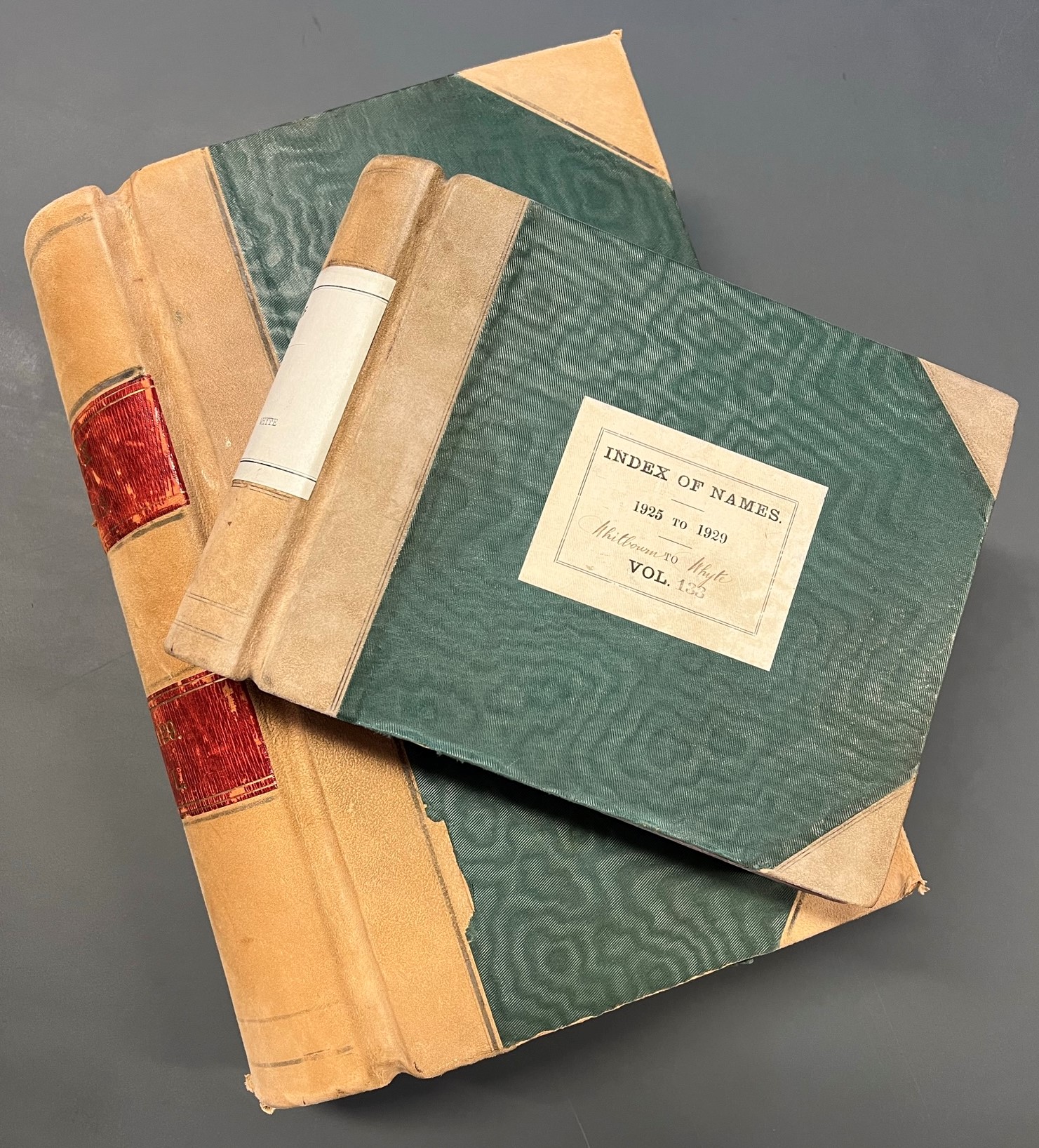
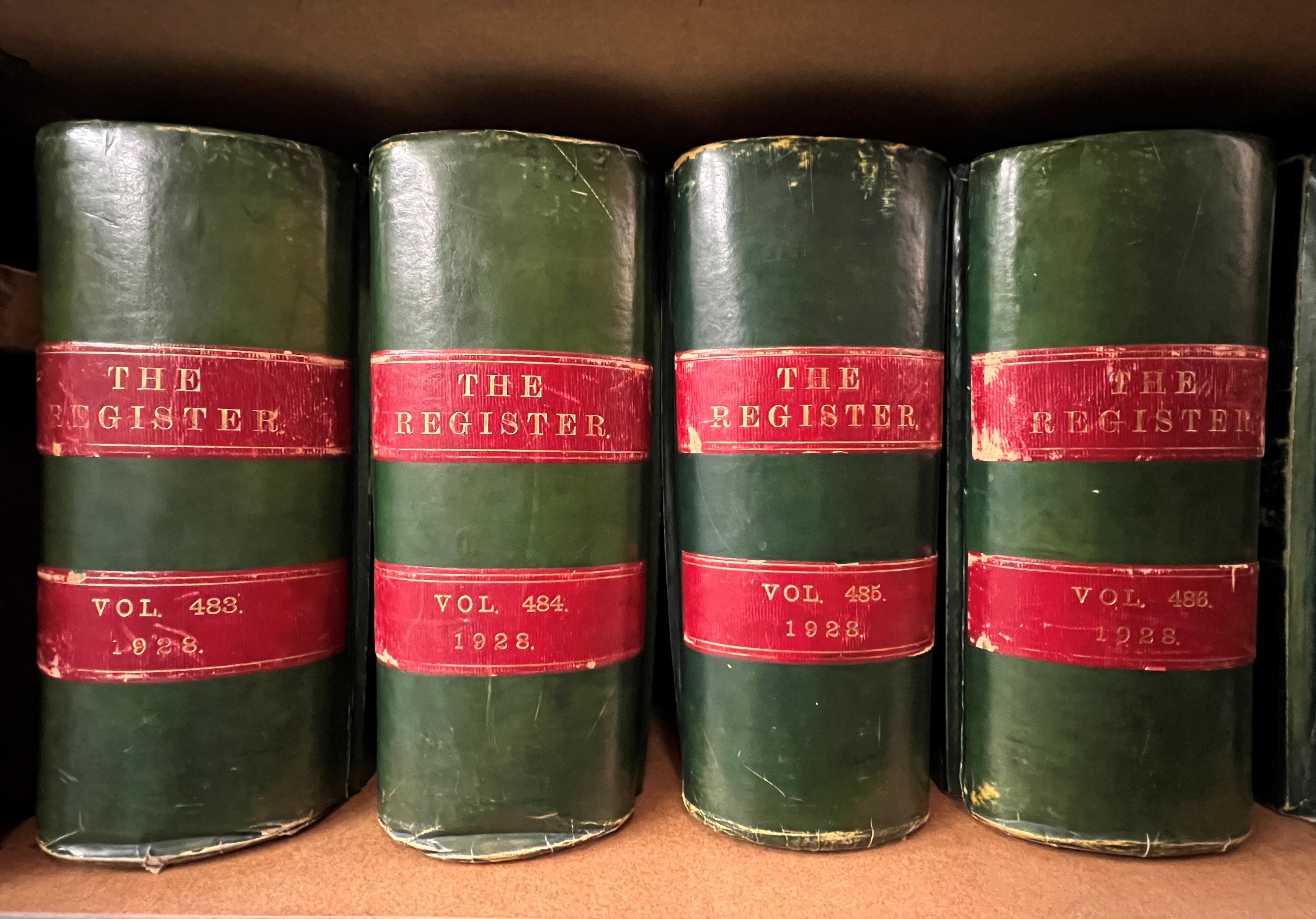
Left to right: index books of names and lands (places) on the search room shelves, with NRRD green-leather-bound deeds volumes for 1928 on Record Office store shelves far right.
Step 1: Work out which indexes to search – either the index of names and/or the index of lands
The post-1885 index books are organised in five-year blocks (e.g. 1885-1889, 1890-1894, 1895-1899 etc.). Within each block, the name index entries are fully alphabetised by surname or company name and likewise the lands (places) index by place-name. Each person or place has its own set of pages, within which entries are arranged chronologically. In both sets of indexes, each entry records the date of registration.
As with the pre-1885 deeds, they are not indexed by detailed address, so you will need to view the deeds themselves to identify which specific property they relate to.
So, to search for Albany Kennett Charlesworth, you could look for them in the names index books working backwards from 1939 (as we know the purchase was before the Second World War), starting with books for 1935-1939, then 1930-1934, 1925-1929 etc.
As Grinton is a small village, it may be quicker to look through the lands (places) index books first, which are similarly organised in five-year blocks: 1935-1939, then 1930-1934, 1925-1929, etc. and skim through all the entries looking for their name as there are only two or three pages of entries for Grinton in each five-year block (see below).
Steps 2 & 3: Search the indexes and work out the relevant deed reference
By looking first at the index to lands, an entry for Albany Kennett Charlesworth can be located under Grinton with Whitaside et Membris in the index of lands 1925-1929, ‘A to L’ (see images below). This entry also records the other parties to the transaction and gives the deed reference in the same three-part format as for the pre-1885 deeds: the volume reference/page number/deed number. In this instance the reference is NRRD 480/598/218.
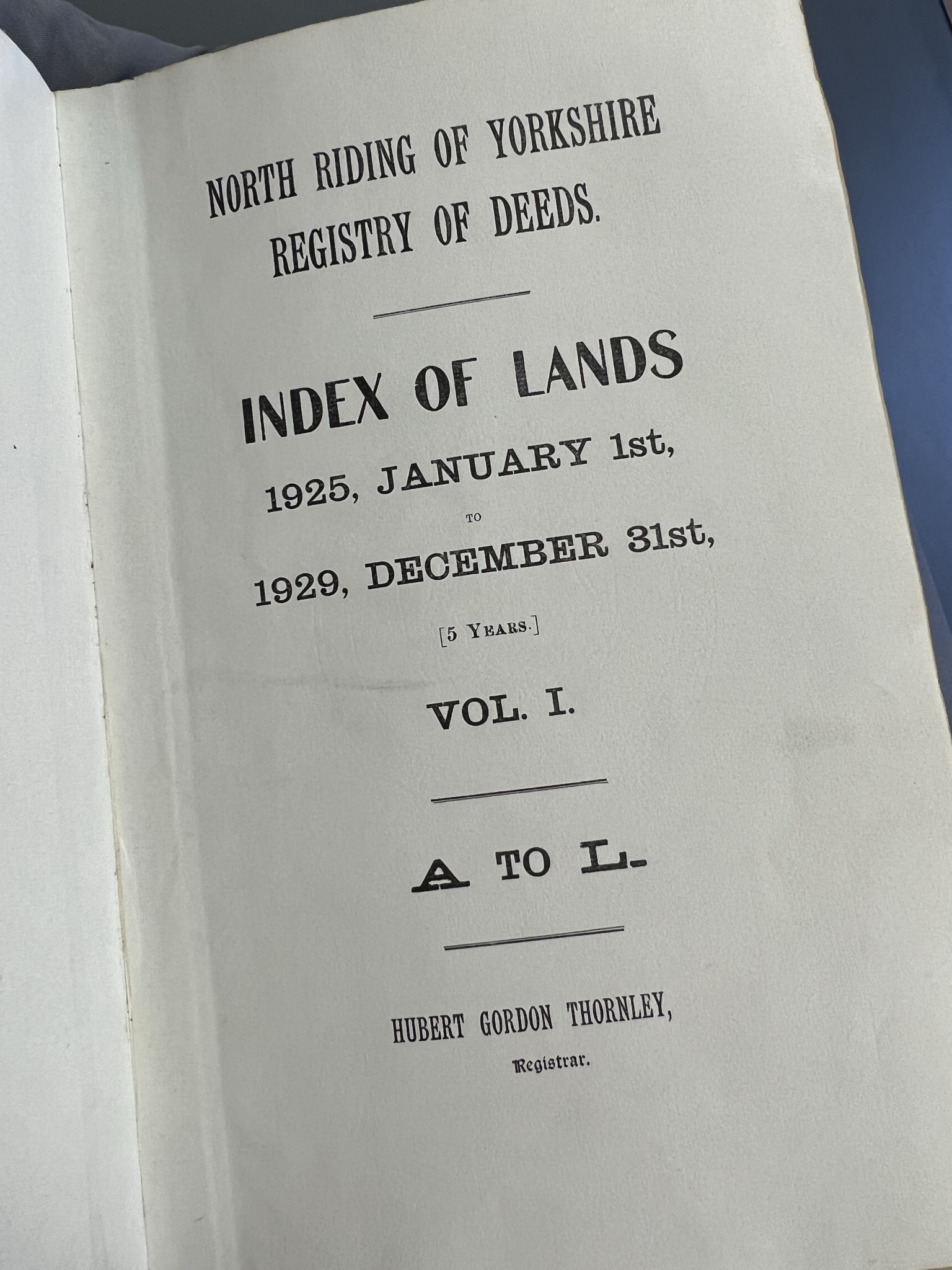
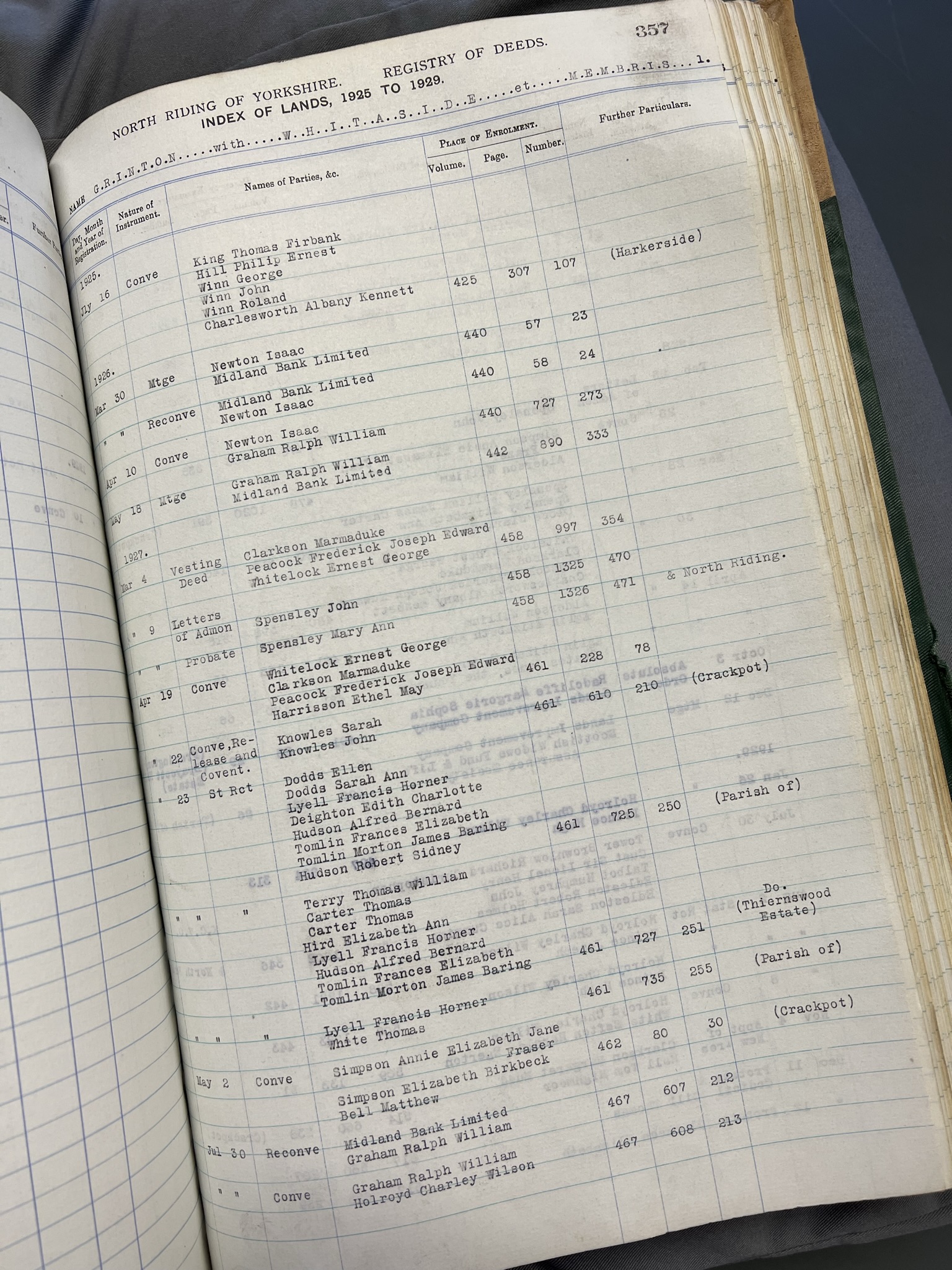
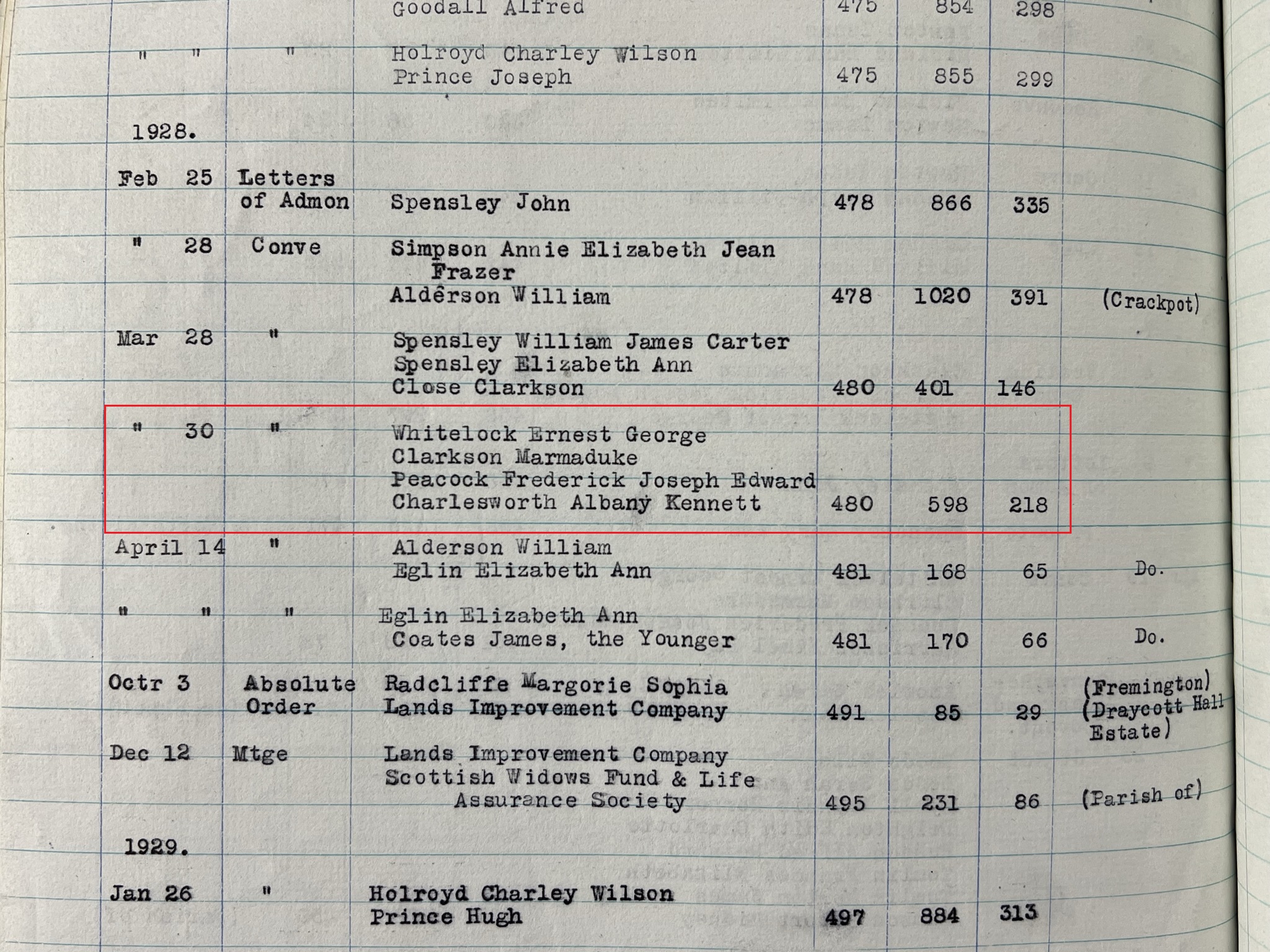
Left to right: Fronticepiece of index of lands for 1925-1929 ‘A to L’; first page of entries for ‘Grinton with Whitaside et membris’ and close-up of entry for Charlesworth, Albany Kennett, 30 March 1928, reference NRRD 480/598/218
A cross-check can be made with the index of names. The images below show the page for Charlesworth, Albany Kennett, in the names index book for 1925-29 ‘Chape to Claridge’ (the surname is listed before the first and middle names). This shows they were involved in three property transactions in this period. The details in the last of the three entries matches with the places index, with an entry for Grinton with Whitaside et Membris dated 30 March 1928, reference NRRD 480/598/218.
You can also look for entries of other parties in the corresponding name index books. In the image below, you can see the name index page for Ernest George Whitelock, the vendor, in the names index book for 1925-29 ‘Whitbourn to Whyte’, which references the same deed. Note that you may find multiple entries in the indexes that have the potential to be the transaction you are searching for. In this instance, unless you have other information to corroborate which entry is the one you are looking for, you will need to ask to see the deeds volumes for each of the potential deeds to identify whether any relate to the property you are interested in.

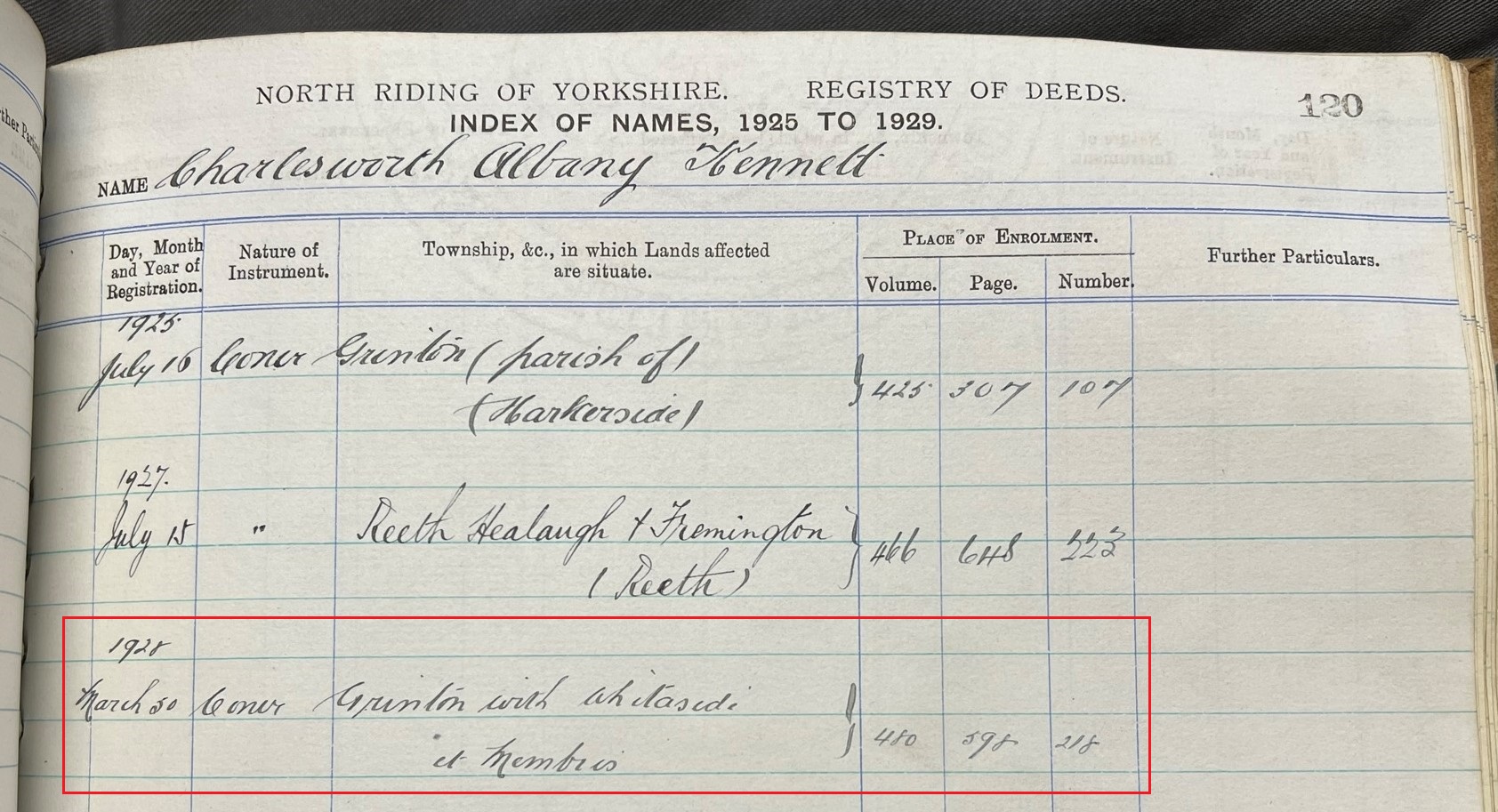

Left to right: Entries for Charlesworth, Albany Kennett & Whitelock, Ernest George in the NRRD index of names 1925-1929 showing property transaction registered on 30 March 1928 at Grinton with Whitaside et Membris, NRRD 480/598/218
Step 4: Request the relevant NRRD volume and view the deed entry
Having located the deed reference, request NRRD volume 480 from search room staff, look up page 598 and deed no. 218 (see images below). You do not need to fill out a document request slip for NRRD volumes.
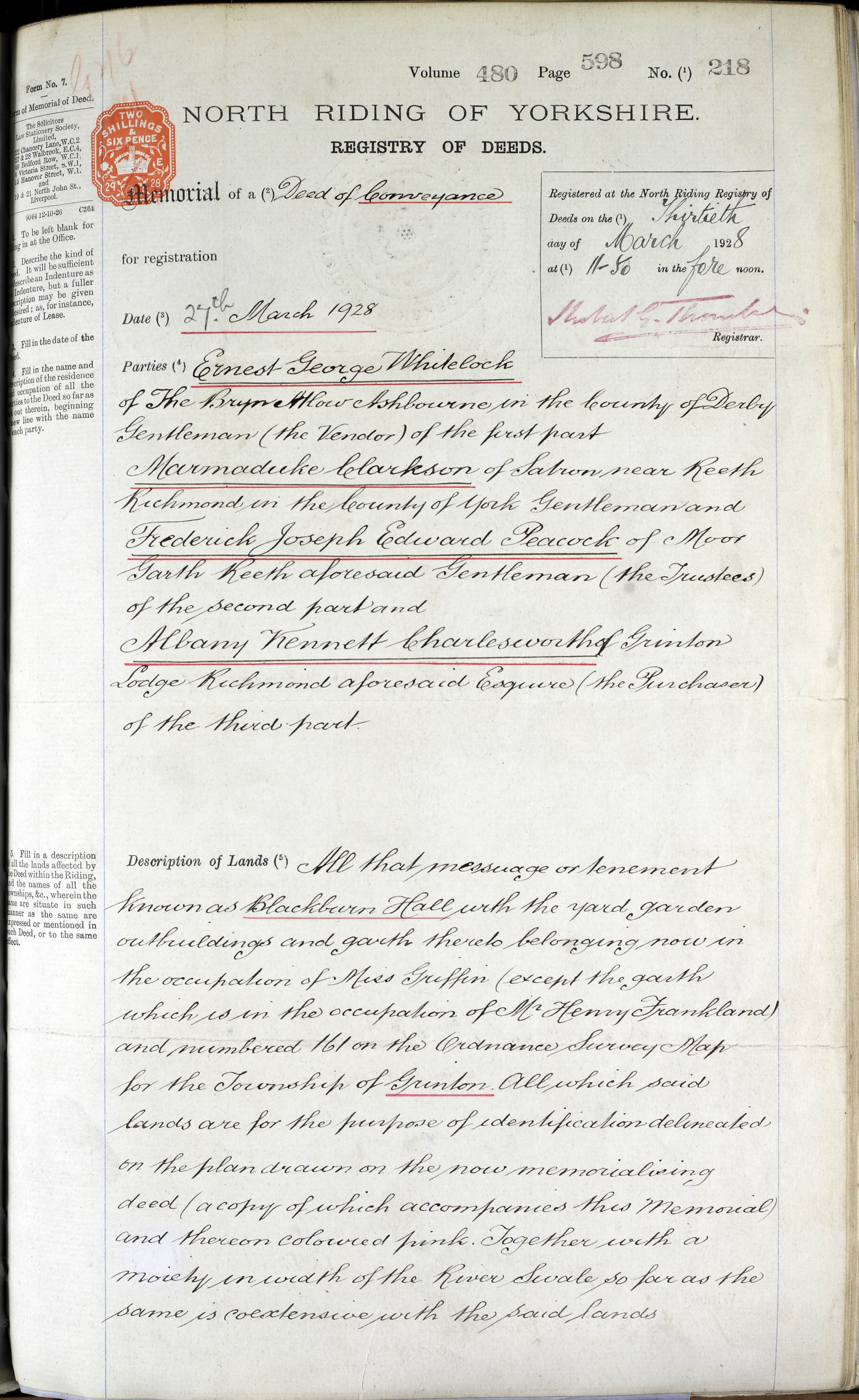

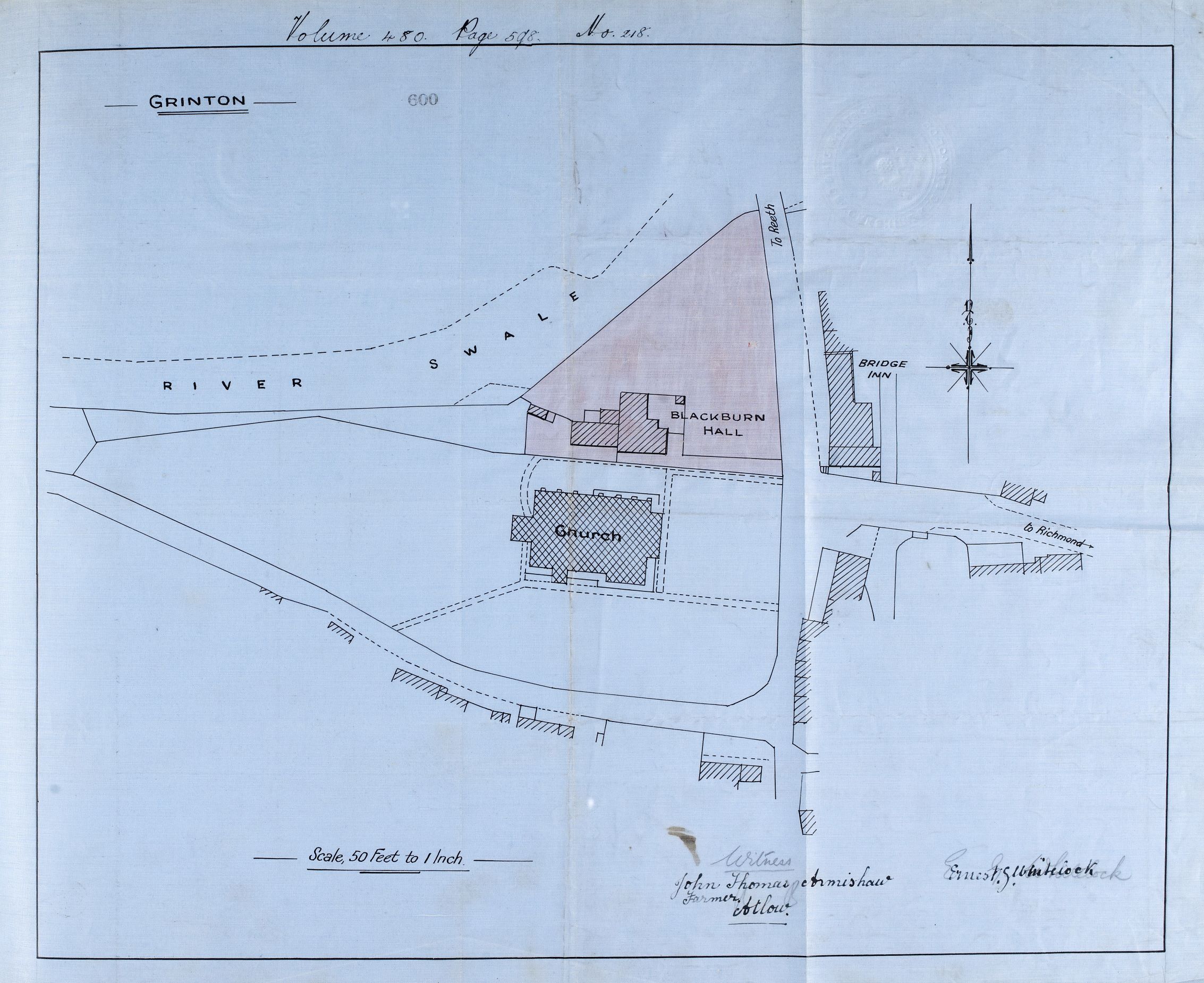
Memorial of a deed of conveyance, with plan, for Blackburn Hall, Grinton, 27 March 1928 (NRRD 480/598/218)
The memorial is a summary of the full deed that was registered and records the following information:
| NRRD reference | 480/598/218 |
| The date of the original transaction | 27 March 1928 |
| The date and time of registration | 30 March 1928 at 11.50 in the forenoon |
| The type of instrument | Memorial (summary) of a deed of conveyance |
| The names of the people (parties) involved | Ernest George Whitelock, of Ashbourne, County of Derby (vendor) Marmaduke Clarkson of Satron near Reeth, Gentleman & Frederick Joseph Edward Peacock of Reeth, Gentleman (Trustees) Albany Kennett Charlesworth of Grinton Lodge, Richmond Esq. (purchaser) |
| A written description of the property | All that messuage or tenement known as Blackburn Hall, Grinton with the yard garden outbuildings & garth now in the occupation of Miss Griffin (except the garth in the occupation of Mr Henry Frankland) numbered 161 on the Ordnance Survey map & delineated in pink on the attached plan &c |
